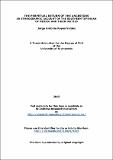Files in this item
The perpetual return of the ancestors : an ethnographic account of the Southern Tepehuan of Mexico and their deities
Item metadata
| dc.contributor.advisor | Gow, Peter | |
| dc.contributor.author | Reyes Valdez, Jorge Antonio | |
| dc.coverage.spatial | 312 p. | en_US |
| dc.date.accessioned | 2016-09-12T11:42:33Z | |
| dc.date.available | 2016-09-12T11:42:33Z | |
| dc.date.issued | 2015 | |
| dc.identifier.uri | https://hdl.handle.net/10023/9478 | |
| dc.description.abstract | This thesis is an ethnographic account of the different ritual domains of interaction between the O’dam of Northern Mexico and their gods. For the O’dam, also known as the Southern Tepehuan, gods, divinities, and different types of spirits have an ancestral character since they are considered as the original inhabitants of the world. It is possible to identify three groups of deities which the O’dam interact with within different ceremonial contexts. Firstly, there are the native ceremonial centres known as xiotalh patios, where the O’dam engage with the gods of agriculture, and hunt. Here, children are initiated in maize-eating, young men are initiated in deer hunting, and the kinship groups renew their vows with the gods of maize. Secondly, within the context of the church and the courthouse, the O’dam interact with the Christian deities through a complex organisation inherited from the Spanish cofradías and cabildos. This group of deities is associated with European activities such as breeding livestock, going to school, and participating in local politics. These relationships between the O’dam and the Christian deities are mainly reproduced by the participation in church festivals. And thirdly, in the domain of the forest the O’dam conduct retreats during five weeks in which they interact with deities and spirits associated with different types of diseases. Since this is the context of shamanic initiation, it is here that individuals learn how to master the spirits responsible for inflicting illnesses, emerging from the retreats with stronger souls which are more resilient to harm. In this work, I approach these three different domains of interaction between the O’dam and their deities from the perspective of ceremonial leaders and shamans, as well as from the perspective of what can be defined as an ‘ordinary person’. | en_US |
| dc.language.iso | en | en_US |
| dc.publisher | University of St Andrews | |
| dc.subject.lcc | F1221.T4R4P4 | |
| dc.subject.lcsh | Tepehuan Indians--Mexico--Santa María de Ocotán y Xoconoxtle--Religion | en_US |
| dc.subject.lcsh | Tepehuan Indians--Mexico--Santa María de Ocotán y Xoconoxtle--Rites and ceremonies | en_US |
| dc.subject.lcsh | Santa María de Ocotán y Xoconoxtle (Mexico)--Religious life and customs | en_US |
| dc.title | The perpetual return of the ancestors : an ethnographic account of the Southern Tepehuan of Mexico and their deities | en_US |
| dc.type | Thesis | en_US |
| dc.contributor.sponsor | Instituto Nacional de Antropoligía e Historia (INAH) (Mexico) | en_US |
| dc.contributor.sponsor | Consejo Nacional de Ciencia y Tecnología (CONACyT) (Mexico) | en_US |
| dc.type.qualificationlevel | Doctoral | en_US |
| dc.type.qualificationname | PhD Doctor of Philosophy | en_US |
| dc.publisher.institution | The University of St Andrews | en_US |
This item appears in the following Collection(s)
Items in the St Andrews Research Repository are protected by copyright, with all rights reserved, unless otherwise indicated.

